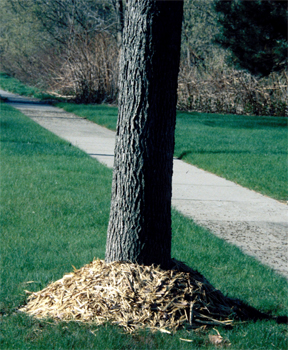Mulch overload!
Good gardeners know the multiple benefits of using organic mulch. Whether in the garden or landscape, mulch helps conserve moisture, reduces weed competition and provides an insulating blanket to moderate soil temperatures. An additional benefit of using organic mulch is that as it breaks down, it contributes organic matter and nutrients to the soil. So when is a good thing too much of a good thing? 
As I drive around the state it seems that epidemic numbers of homeowners or maintenance companies are piling big “volcanos” of mulch right at the base of each tree. It does not take a plant surgeon to figure out that this dark, moist environment is an invitation for root rot and insect invasion. It also increases surface rooting into the mulch itself which provides an unnatural environment for growth.
Correct method
At planting time, mulch such as shredded bark can be used at about 3-4 inches deep (for the initial application) in a circular pattern at the base of the tree or shrub within the “drip zone” (zone underneath the canopy). The mulch should be applied as a thin 1-inch layer immediately next to the trunk or stems, which gradually gets thicker as you move outward. Most tree and shrub roots establish themselves well away from the leaf canopy, so a two-foot circle of mulch at the base of a tree will do little except keep the mower and weed whackers away from the trunk. If it’s possible to develop several groupings of trees or plants into beds you will be much better off.
Thick, yearly applications of mulch are becoming a general practice too. Landscapes look fresh and healthy with newly applied bark mulch around beds and plant material. The problem is, again – too much mulch. If you are going to spruce up the beds every year, do it modestly – apply 1 to 2 inches max. Where mulch applications have become crusted and hard, break up the clods and pull excess out to the edge of the bed or drip line. Layers upon layers of dried organic mulch can also create an impervious barrier to water and nutrients. Making a mulch ring bigger each year not only benefits trees, but means less mowing right? Just remember, too much of a good thing is just . . . too mulch!
Read more gardening news at Rebecca’s blog at: www.stuckongardeing.com
Related Source:
Gardening in Michigan



 Print
Print Email
Email


